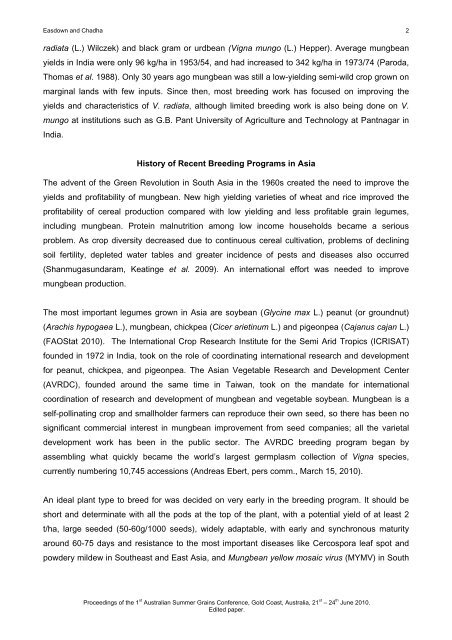4th International Crop Science Congress - Grains Research ...
4th International Crop Science Congress - Grains Research ...
4th International Crop Science Congress - Grains Research ...
You also want an ePaper? Increase the reach of your titles
YUMPU automatically turns print PDFs into web optimized ePapers that Google loves.
Easdown and Chadha 2radiata (L.) Wilczek) and black gram or urdbean (Vigna mungo (L.) Hepper). Average mungbeanyields in India were only 96 kg/ha in 1953/54, and had increased to 342 kg/ha in 1973/74 (Paroda,Thomas et al. 1988). Only 30 years ago mungbean was still a low-yielding semi-wild crop grown onmarginal lands with few inputs. Since then, most breeding work has focused on improving theyields and characteristics of V. radiata, although limited breeding work is also being done on V.mungo at institutions such as G.B. Pant University of Agriculture and Technology at Pantnagar inIndia.History of Recent Breeding Programs in AsiaThe advent of the Green Revolution in South Asia in the 1960s created the need to improve theyields and profitability of mungbean. New high yielding varieties of wheat and rice improved theprofitability of cereal production compared with low yielding and less profitable grain legumes,including mungbean. Protein malnutrition among low income households became a seriousproblem. As crop diversity decreased due to continuous cereal cultivation, problems of decliningsoil fertility, depleted water tables and greater incidence of pests and diseases also occurred(Shanmugasundaram, Keatinge et al. 2009). An international effort was needed to improvemungbean production.The most important legumes grown in Asia are soybean (Glycine max L.) peanut (or groundnut)(Arachis hypogaea L.), mungbean, chickpea (Cicer arietinum L.) and pigeonpea (Cajanus cajan L.)(FAOStat 2010). The <strong>International</strong> <strong>Crop</strong> <strong>Research</strong> Institute for the Semi Arid Tropics (ICRISAT)founded in 1972 in India, took on the role of coordinating international research and developmentfor peanut, chickpea, and pigeonpea. The Asian Vegetable <strong>Research</strong> and Development Center(AVRDC), founded around the same time in Taiwan, took on the mandate for internationalcoordination of research and development of mungbean and vegetable soybean. Mungbean is aself-pollinating crop and smallholder farmers can reproduce their own seed, so there has been nosignificant commercial interest in mungbean improvement from seed companies; all the varietaldevelopment work has been in the public sector. The AVRDC breeding program began byassembling what quickly became the world’s largest germplasm collection of Vigna species,currently numbering 10,745 accessions (Andreas Ebert, pers comm., March 15, 2010).An ideal plant type to breed for was decided on very early in the breeding program. It should beshort and determinate with all the pods at the top of the plant, with a potential yield of at least 2t/ha, large seeded (50-60g/1000 seeds), widely adaptable, with early and synchronous maturityaround 60-75 days and resistance to the most important diseases like Cercospora leaf spot andpowdery mildew in Southeast and East Asia, and Mungbean yellow mosaic virus (MYMV) in SouthProceedings of the 1 st Australian Summer <strong>Grains</strong> Conference, Gold Coast, Australia, 21 st – 24 th June 2010.Edited paper.
















